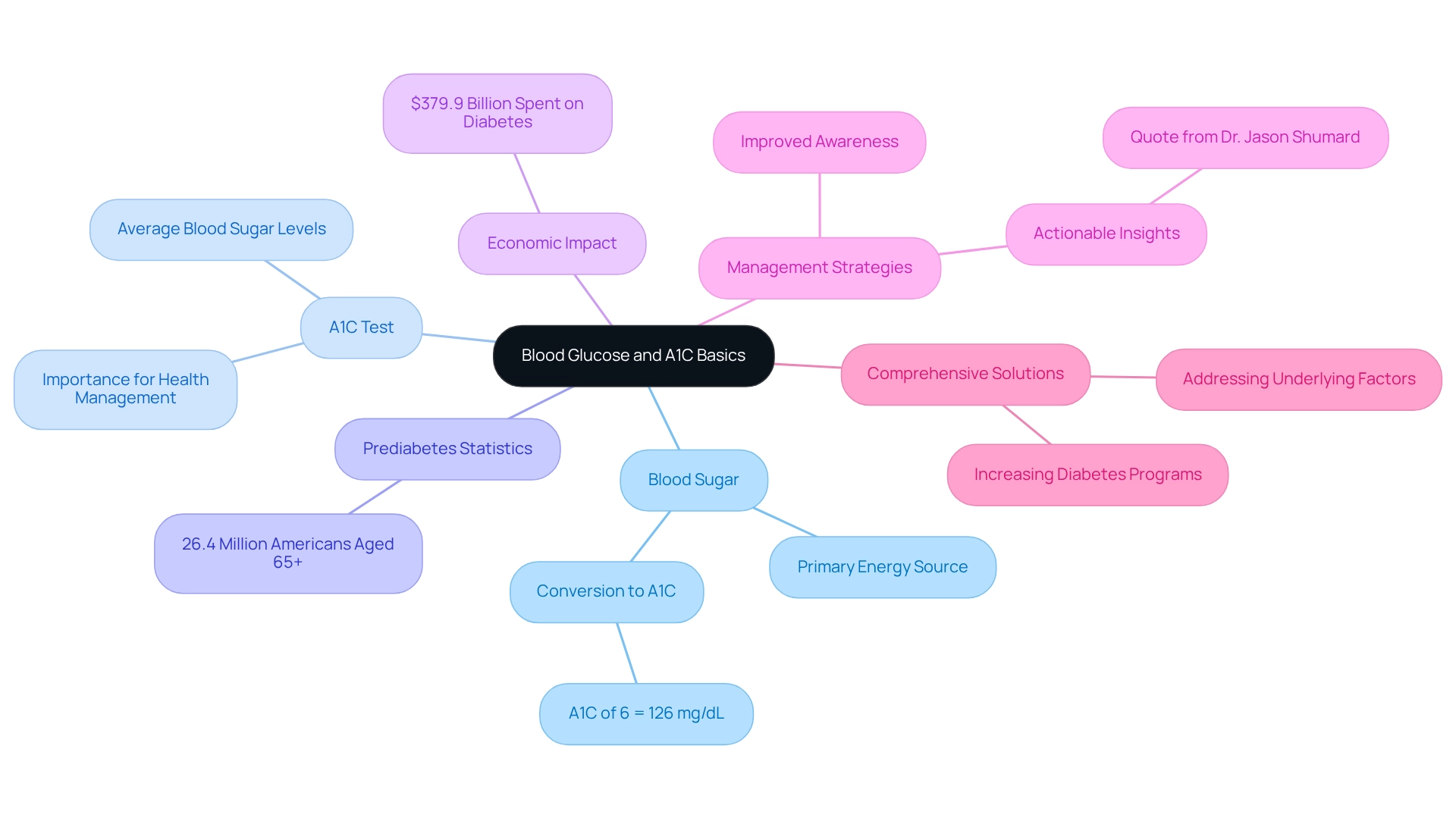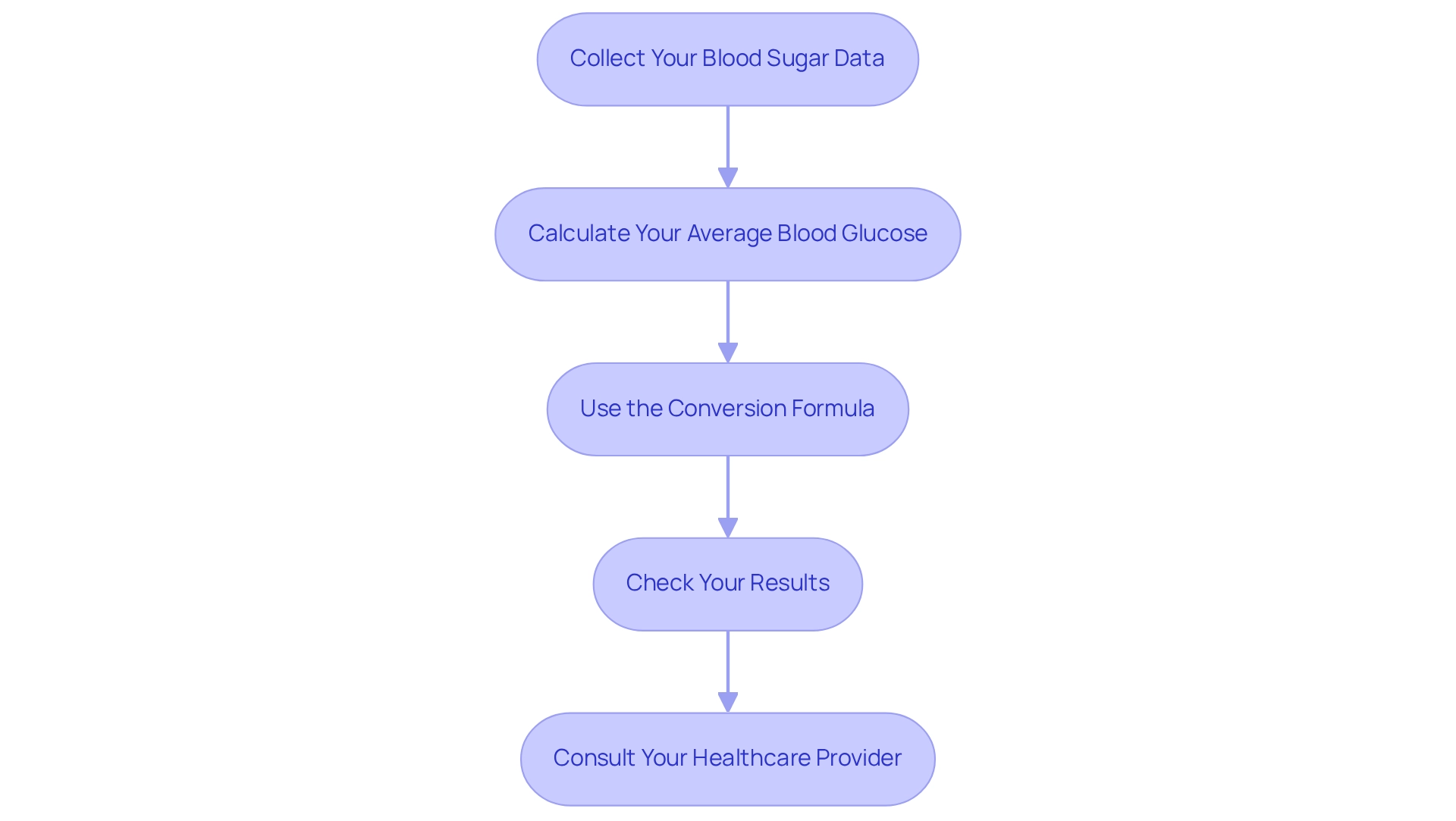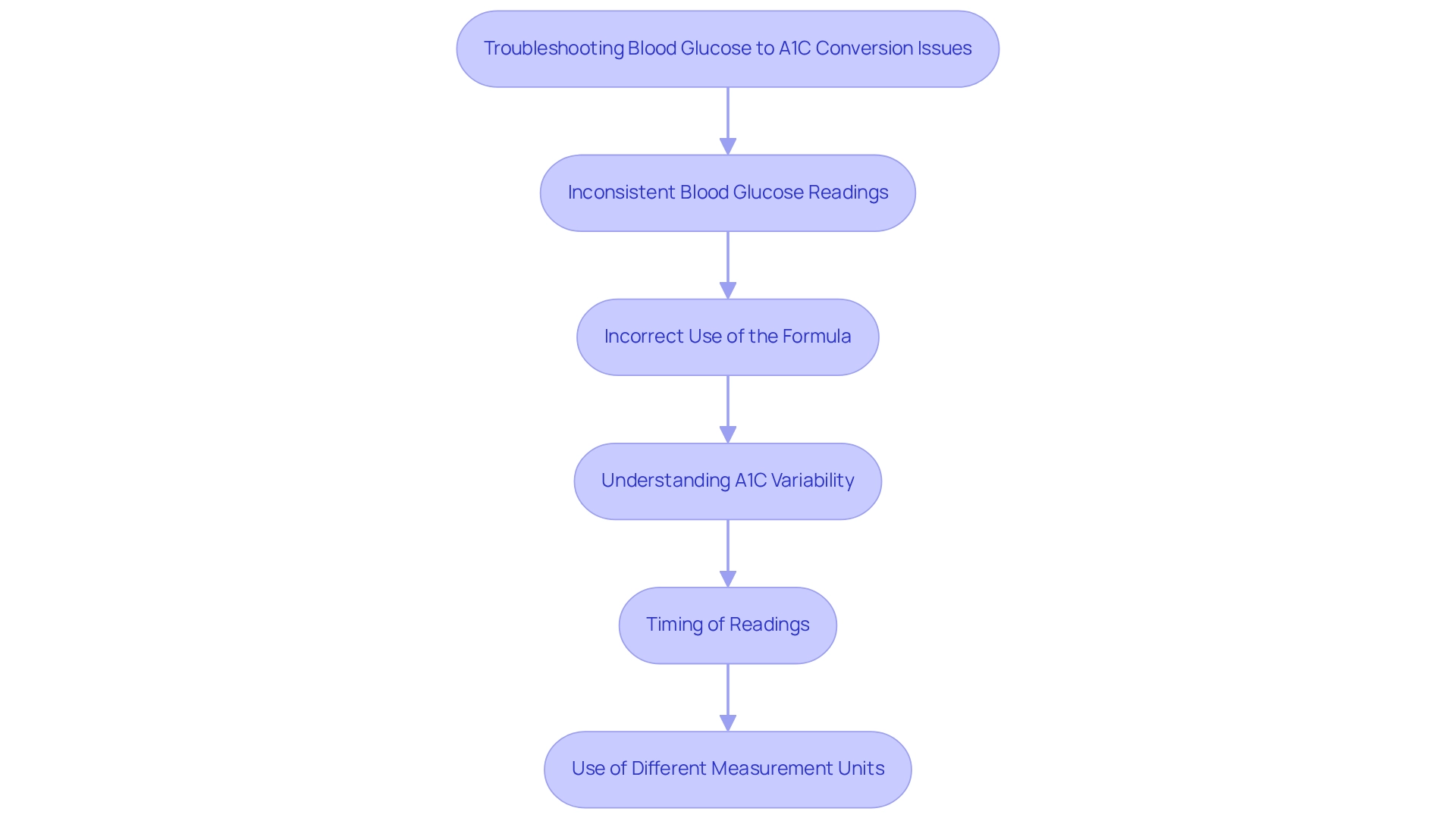Overview
Managing diabetes can often feel overwhelming, especially when it comes to understanding blood glucose levels and A1C values. This article gently guides you through a straightforward step-by-step process to convert these metrics, ensuring you feel supported every step of the way.
It’s important to recognize that grasping these numbers is crucial for effective diabetes management. By accurately collecting data and calculating your A1C, you empower yourself to make informed decisions about your health. Consulting with healthcare providers is also vital, as their expertise can significantly enhance your health outcomes.
Many patients find that taking control of their health leads to a greater sense of well-being. This journey is not just about numbers; it’s about your overall quality of life. Together, we can navigate these challenges, fostering a healthier future.
As you embark on this path, remember that you are not alone. Embrace this opportunity to learn and grow, and consider joining the 30-Day Diabetes Reset program for further support and guidance. Your health is worth it.
Introduction
In the intricate world of diabetes management, it’s important to recognize the significant role that blood glucose levels and A1C play in your health journey. Blood glucose, the essential sugar fueling your body’s energy, is complemented by the A1C test, which provides a glimpse into your average glucose levels over the past few months. Many patients find that understanding these measurements can be both empowering and enlightening. As diabetes continues to affect millions, particularly older adults, the importance of these metrics cannot be overstated.
With billions spent on diabetes-related healthcare, gaining insights into these critical numbers not only supports your well-being but also opens the door to improved health outcomes. This article aims to explore the foundational concepts of blood glucose and A1C, share practical steps for conversion, and highlight common pitfalls to avoid. By equipping you with this knowledge, we hope to guide you toward effective diabetes management and a healthier lifestyle.
Understand Blood Glucose and A1C Basics
Blood sugar, that sweet substance coursing through your bloodstream, serves as the primary energy source for your body. A1C, or hemoglobin A1C, is a vital blood test that reveals your average blood sugar levels over the last two to three months, which is essential for blood glucose to A1C conversion. This test result is expressed as a percentage, indicating the proportion of hemoglobin molecules coated with sugar. For instance, the blood glucose to A1C conversion indicates that an A1C of 6% corresponds to an average blood sugar level of approximately 126 mg/dL. Understanding these metrics is crucial for effectively managing your health, as they empower you to track your well-being and make informed decisions.
It’s important to recognize that around 26.4 million Americans aged 65 and older are living with prediabetes. This makes understanding the connection between blood sugar levels and the blood glucose to A1C conversion even more significant. Many patients find that improved awareness of these measurements can lead to better management strategies, ultimately enhancing their outcomes. Furthermore, the U.S. spends about $379.9 billion on diabetes, highlighting the economic impact of this condition and the urgent need for effective management, especially when it comes to the blood glucose to A1C conversion, which is a proactive step toward reclaiming your wellness journey. As Dr. Jason Shumard notes, ‘By providing patients with actionable insights and practical tools, the center fosters an environment where individuals can reclaim their wellness and well-being, ultimately leading to improved quality of life and reduced reliance on conventional medical interventions.’
It’s essential to acknowledge that traditional treatments for blood sugar issues, like insulin injections, may inadvertently worsen insulin resistance, complicating management efforts. This underscores the importance of exploring comprehensive health solutions that address the underlying factors of the condition rather than merely managing symptoms.
With concerning statistics indicating that 7,000 erroneous medications are administered in hospitals and 80,000 infections contracted by patients, the need for secure management of blood sugar levels is more pressing than ever. The growing number of organizations offering programs for blood sugar control reflects an expanding awareness of the importance of prevention and management in various areas. This collective awareness can significantly contribute to better health outcomes for individuals living with diabetes.
Follow Step-by-Step Conversion Process
The blood glucose to A1C conversion can feel overwhelming, but you’re not alone. Here’s a compassionate guide to help you through the process:
- Collect Your Blood Sugar Data: Begin by using tracking methods like fitness apps, journals, or pedometers to consistently record your blood sugar readings over at least two weeks. This practice not only helps you monitor your progress but also aligns with the SMART goal-setting approach. By setting specific targets for your health, you empower yourself to take charge.
- Calculate Your Average Blood Glucose: To find your average, simply sum all your readings and divide by the total number of readings. Regularly reviewing this data fosters accountability and allows you to adapt your goals as needed. Remember, it’s okay to adjust your targets based on your experiences.
- Use the Conversion Formula: Now, apply the formula: A1C (%) = (Average Blood Glucose (mg/dL) + 46.7) / 28.7. For example, if your average blood sugar is 150 mg/dL, the calculation would be (150 + 46.7) / 28.7, resulting in approximately 6.9% A1C. It’s important to note that an A1C of 240 corresponds to an estimated average glucose (eAG) of 13.4 mg/dL, illustrating the connection between these measurements.
- Check Your Results: Take a moment to compare your A1C result against the recommended targets for managing blood sugar levels. Typically, this is below 7% for most adults. Setting achievable goals based on these results can significantly enhance your motivation and focus, helping you feel more in control.
- Consult Your Healthcare Provider: Finally, discussing your results with your healthcare provider is crucial. Understanding their implications for your treatment plan empowers you in your wellness journey. Engaging in this conversation can provide clarity and support as you navigate your health, and understanding the blood glucose to A1C conversion empowers you to take control of your diabetes management. Regular self-testing offers essential insights into daily fluctuations, enhancing your interpretation of A1C results. This knowledge promotes proactive wellness management and aligns with the holistic approach advocated by Dr. Shumard, emphasizing the importance of patient education in achieving lasting well-being outcomes. As highlighted in the case study ‘Patient Education and Empowerment,’ Dr. Shumard’s teaching initiatives have profoundly influenced patients, inspiring them to take proactive steps in managing their health.
Troubleshoot Common Conversion Issues
When converting blood glucose to A1C, it’s essential to acknowledge the common challenges that may arise:
- Inconsistent Blood Glucose Readings: To achieve reliable results, it’s crucial to take readings at the same times each day. Have you ever noticed how variability in timing can significantly skew your average? This can lead to misleading A1C results. With the rising prevalence of type 2 diabetes—evidenced by the diagnosis of 5,293 children and adolescents aged 10 to 19 years in 2017-2018—accurate monitoring is more important than ever. A tailored approach, as promoted by Dr. Jason Shumard, emphasizes understanding your unique wellness profile through thorough evaluations and diagnostic tests, enhancing your monitoring practices.
- Incorrect Use of the Formula: Accuracy in calculations is vital. Have you ever made a minor arithmetic error that resulted in substantial discrepancies? Always double-check your math to ensure precision, as this attention to detail is integral to effectively managing your health.
- Understanding A1C Variability: It’s important to recognize that factors such as anemia or other medical conditions can influence A1C results. If you have any underlying medical issues, consulting your healthcare provider for personalized guidance tailored to your situation is advisable. As the Cleveland Clinic states, “Whether you’ve been living with diabetes for years or you’re newly diagnosed, you want experts you can trust.” This aligns with the functional medicine approach, which seeks to address the root causes of health issues, ensuring that all aspects of your health are considered.
- Timing of Readings: Many patients find that blood sugar levels naturally vary throughout the day. For a more precise average, consider averaging readings taken at different times, such as fasting and post-meal, to capture a comprehensive picture of your blood sugar levels. This broader perspective is crucial for effective management of the condition.
- Use of Different Measurement Units: Be mindful of the measurement units in use (mg/dL vs. mmol/L). If necessary, convert them appropriately; for example, to convert mg/dL to mmol/L, divide by 18. This ensures that you are interpreting your results correctly.
Addressing these common issues can significantly enhance your understanding of blood glucose management and the blood glucose to A1C conversion relationship. Furthermore, data from a case study titled “Emergency Department Disposition for Diabetic Patients” revealed that 54.9% of patients with diabetes were treated and released, while 38.4% were admitted to the hospital. This highlights the varying severity of diabetes-related emergencies and underscores the importance of accurate A1C readings in managing health effectively. Ultimately, this empowers you to take control of your health through informed lifestyle modifications while being mindful of hospital safety concerns.
Conclusion
Understanding blood glucose levels and A1C is essential for effective diabetes management. Blood glucose serves as the primary energy source for the body, while A1C reflects the average glucose levels over the past few months, providing critical insights into your health journey. By grasping these concepts and their interrelation, you can empower yourself to take charge of your diabetes management, ultimately leading to better health outcomes.
It’s important to recognize that translating blood glucose readings into A1C percentages can be a straightforward process. This step-by-step conversion ensures that you can set achievable health goals. This proactive approach fosters accountability and encourages regular communication with your healthcare providers, which is vital for tailoring treatment plans and enhancing your overall well-being.
Many patients find that addressing common pitfalls in the conversion process is crucial for maintaining accurate readings. Inconsistency in blood glucose monitoring, calculation errors, and external factors like underlying health conditions can skew results. By adopting best practices for reliable data collection, you can navigate these challenges more effectively, leading to improved health and quality of life.
Ultimately, knowledge is power in the realm of diabetes management. By understanding the significance of blood glucose and A1C, engaging in consistent monitoring, and addressing potential issues, you can take informed steps toward a healthier future. This journey can reduce your reliance on conventional medical interventions and enhance your overall quality of life.
Frequently Asked Questions
What is blood sugar and why is it important?
Blood sugar is the primary energy source for your body, coursing through your bloodstream and providing fuel for various bodily functions.
What is A1C and what does it measure?
A1C, or hemoglobin A1C, is a blood test that reveals average blood sugar levels over the last two to three months, expressed as a percentage of hemoglobin molecules coated with sugar.
How does the blood glucose to A1C conversion work?
The blood glucose to A1C conversion indicates that an A1C of 6% corresponds to an average blood sugar level of approximately 126 mg/dL.
Why is understanding blood sugar and A1C metrics important?
Understanding these metrics is crucial for effectively managing health, as they empower individuals to track their well-being and make informed health decisions.
How prevalent is prediabetes among older Americans?
Approximately 26.4 million Americans aged 65 and older are living with prediabetes, highlighting the significance of understanding blood sugar levels and A1C conversion.
What impact does improved awareness of blood sugar measurements have on patients?
Many patients find that improved awareness of blood sugar and A1C measurements can lead to better management strategies and enhanced health outcomes.
What is the economic impact of diabetes in the U.S.?
The U.S. spends about $379.9 billion on diabetes, emphasizing the urgent need for effective management strategies.
What concerns are associated with traditional treatments for blood sugar issues?
Traditional treatments, like insulin injections, may worsen insulin resistance, complicating management efforts and highlighting the need for comprehensive health solutions.
Why is secure management of blood sugar levels increasingly important?
With rising statistics of erroneous medication administration and hospital infections, secure management of blood sugar levels is crucial for patient safety and health outcomes.
How are organizations responding to the need for blood sugar control?
There is a growing number of organizations offering programs for blood sugar control, reflecting an expanding awareness of the importance of prevention and management in diabetes care.


